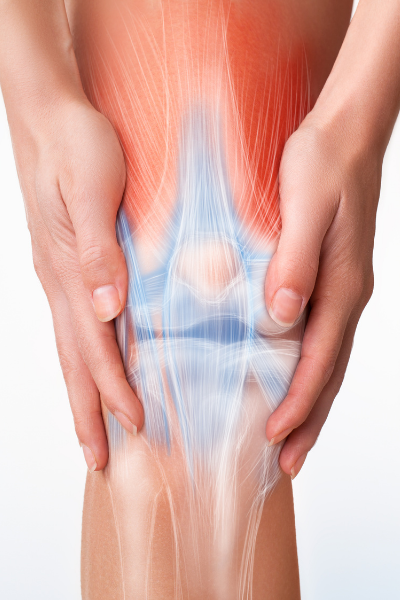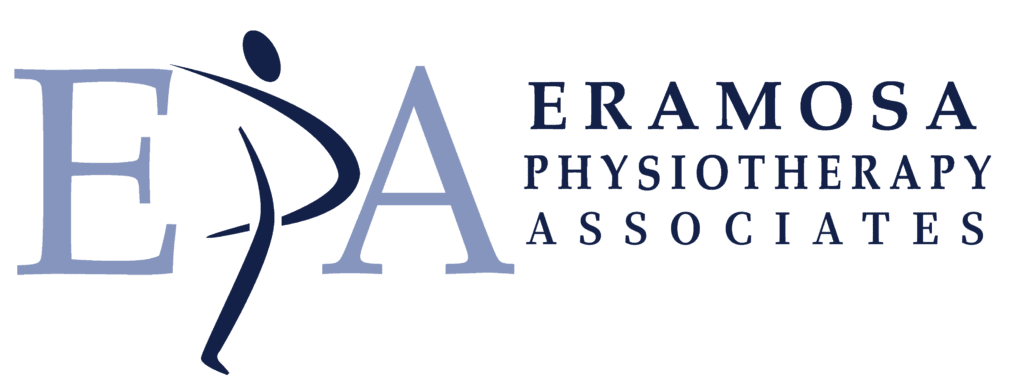Knee Physiotherapy at EPA

1. Clarifying your Knee Pain
Knee physiotherapy for pain ranks as one of EPA’s top 3 most commonly assessed joints, and our approach to knee pain follows our Path to Improved Health. Knee pain spans the age spectrum.
- Young teenagers can experience sharp pain that literally stops them in their tracks, with simple activities like sitting too long or walking down a flight of stairs.
- Athletes of all levels, from the weekend warriors to the elite in training, may have heard a loud “pop” during a plant and twist or the feeling of giving way when they least expect it.
- Commonly, clients of all ages and activity levels experience a sharp pain in front or even behind their knee with that everyday twist or bend that results in their knee swelling and making bending or straightening completely impossible.
Many patients simply notice a gradual decline in their knee function. For some, it is knee pain, for others, knee swelling or the loss of their regular knee movement. Often, they really can’t even pinpoint a specific incident.
Common medical diagnoses for knee physiotherapy clients with pain:
- Patellofemoral Pain/Syndrome (PFP, PFS) Learn More
- Ligament Sprain Learn More
- Anterior Cruciate Ligament (ACL) Tear Learn More
- Meniscus or Cartilage Tear Learn More
- Knee Osteoarthritis Learn More
- Patellar Tendinopathy (Jumpers Knee) Learn More
- Fractures from Trauma
2. Knee Pain can be a result of:
Knee pain has a variety of sources and can be a gradual, slow declining process, or appear suddenly with an abrupt or otherwise typical movement.
The knee is somewhat unique in that often the source or symptom of knee pain is not always the cause. Research is pointing to the muscles of the hip and thigh bone (femur) to be critical in providing a sound foundation for the many structures or systems that can cause knee pain. Structures leading to knee pain include:
- Tears in the meniscus or cartilage
- Sprains and tears of the ligaments, most commonly noted are Anterior Cruciate Ligament (ACL) and Medial Collateral Ligament (MCL)
- Osteoarthritis in the joint space
- Loose bodies in the joint space
- Poor biomechanics between the hip, knee and foot
- Stiff knee joint or knee cap movement
- Obesity and general inactivity




3. Knee Physiotherapy Treatment to Improve your Knee Pain
Knee physiotherapy and treatment for your knee pain, regardless of the source of the pain, often requires a diverse, multi-modal approach.
- Hands-on knee physiotherapy, such as mobilization, traction, soft tissue techniques, or, when appropriate, manipulation to regain as much movement as possible
- Modalities for pain control like electrotherapies, heat/ice or acupuncture to assist in minimizing knee swelling
- Strengthening exercises to initially recover muscle function but progressing to critical strengthening and any sport-specific performance training
- Balance and proprioception exercises to improve the control of the knee position
- Education regarding vulnerable knee positions and exercises that are known to be preventative in nature for many knee pain sources of pain
- Consideration is given to knee bracing when appropriate
Most initial knee pain resolves in 6 – 8 weeks, and typically by week 4, there is a considerable improvement. Your commitment is typically 2-3 weeks for 20 – 30 minutes, in addition to participation in progressive in the clinic and home exercises.
In the less likely event that your knee pain is not demonstrating improvement, we will work with you and your family doctor to explore other diagnostic imaging or tests. While the vast majority of knee pain is treated conservatively, without the need for surgical intervention, some clients may need to consult a Surgeon. While this is by far the exception, our Path to Improved Health process will recognize these symptoms, communicate with your family doctor and be ready to assist you with post-surgery recommendations.
Our goal is to return you to your pre-knee pain level of function and to assist in preventing reoccurrence. Whether that means getting back to work, sport or simply enabling you to walk down the stairs or get out of your chair comfortably.
4. Knee Physiotherapy Discharge Review
We strive to provide a timely and cost-effective knee physiotherapy treatment plan with the end goal of instilling confidence in all of our clients through the exercises, education and tools provided. We will ensure that our clients are connected to resources in their community. Our team approach is aimed at meeting our client’s goals and improving their quality of life.
5. Discharge Peak Review
At EPA we value a team approach. Our clients are always welcome to reach out to us for support and encouragement, or with questions surrounding their condition or program. We are committed to keeping our clients on their Path to Improved Health


